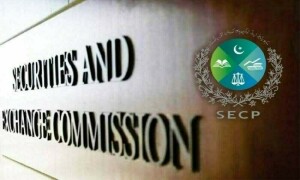Lending rates will still go up: SBP maintains its key policy rate at 14 percent
Borrowing cost of private sector is bound to go up as the government shifts, albeit reluctantly, its borrowings for budgetary needs towards the commercial banks despite State Bank of Pakistan''s decision to maintain its policy rate at 14 percent.
According to monetary experts, the fundamental issue hampering the economy is lack of required liquidity. Lending rates will keep on increasing until exchequer''s access to the liquidity pool is cut off. This implies forcing a reversal of the fiscal deficit''s upward trend. Postponing additional revenue measures (RGST & Flood surcharge), rolling back POL retail price increases, and freezing electricity tariffs cumulatively could result in the fiscal deficit to even a whopping nine percent of the GDP - a range which has horrendous consequences.
Ministry of Finance and SBP have conveyed this highly anticipated scenario to the Federal Cabinet as well as to the political leadership in the opposition. The International Monetary Fund as well as the US authorities are on the same page.
SBP: The Governor SBP, Shahid H. Kardar, in the January 29, 2011 monetary policy statement spoke about the governmental commitment to freeze its borrowing from SBP at Rs 1,290 billion. He also stated that as of January 23rd, the stock of Federal borrowing from SBP was Rs 1,277 billion. SBP''s cumulative flow chart of governmental borrowing shows a shift of over Rs 200 billion from SBP to commercial banks. It is feared that this situation is bound to persist for the next couple of months even if consensus on an economic reform agenda or grand economic strategy among political parties is consequentially evolved. As a consequence, banks will keep on squeezing private sector credits and lock-up additional liquidity in their governmental portfolio. Therefore, when private sector credit limits come up for renewal, banks will want adjustments or else higher interest rate. There are genuine fears that government borrowing from the banking system will not abate.
The Governor SBP had hinted at a way out, last Saturday; reducing the currency-in-circulation turning them into bank deposits. A reduction of Rs 100 to 150 billion in currency-in-circulations with a multiplier of 3.3 (estimated in our system) could possibly dilute the impact of a shift of commercial bank lending towards the government and keep market rates stable. But to achieve this, government needs to make changes in its taxation system whereby people are encouraged to put their money in a bank instead of under a pillow.
NFA & NDA: The trend of fiscal deficit is connected with fuelling of inflation. SBP has to block governmental borrowing - all else is beating around the bush. So the message has to be "no direct borrowing from SBP either by the federal and provincial governments or for bailouts of public sector enterprises."
The only reason for reduction in governmental borrowing from SBP was the $743 million Coalition Support Fund inflow. Higher inflows of home remittances or improvement in export proceeds do help the balance of payment position and the current account, but they do cause no impact on the stock of governmental borrowing from SBP.
Besides, CSF inflow of aid and loans results in reducing governmental borrowing from the banking system. At budget time, inflow from Friends of Pakistan and multilateral agencies was estimated at $3.5 billion. Only $550 million has come in so far. CSF reimbursement was envisaged at $1.3 billion, only 810 million dollars have been received. With no resolution with the Fund in sight - the possibility of growth in NFA is slim and at best NFA will be stable due to price increase for cotton and rice coupled with a rise in HR. Even the receipt of $100 million from Etisalat for PTCL is doubtful during the current financial year.
With inflation touching 16 percent, holding the policy rate at 14 percent means that the gap between the two could widen. And, SBP may have to play catch-up - two months from now.
With commodities showing an upward tick and internal crisis in the Middle East escalating the pressures on imports are likely to continue.
It appears that this time SBP has tilted towards the political rhetoric emanating from Islamabad as the fundamentals have not undergone a material change. After the roll-back of OGRA fixed prices, the Monetary Policy committee of SBP did not want to be wrong footed and has decided to opt for a wait-and-see policy, because a reversal on account of political pressure would have meant losing respect in the eyes of the market.
























Comments
Comments are closed.